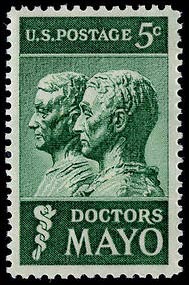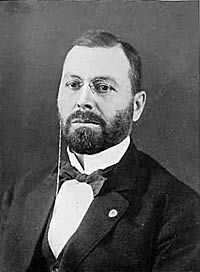Readings:
Psalm 91:9-14
Sirach 38:1-8
Acts 5:12-16
Luke 8:40-56Preface of the Epiphany
[Common of a Saint]
[For Vocation in Daily Life]
[For the Ministry III]
[For the Sick]
[For Social Service]
PRAYER (traditional language)
Divine Physician, your Name is blessed for the work and witness of the
Mayos and the Menningers, and the revolutionary developments that they
brought to the practice of medicine. As Jesus went about healing the sick
as a sign of the reign of God come near, bless and guide all those inspired
to the work of healing by thy Holy Spirit, that they may follow his example
for the sake of thy kingdom and the health of thy people; through the
same Jesus Christ, who with thee and the Holy Spirit livest and reignest,
one God, now and for ever. Amen.
PRAYER (contemporary language)
Divine Physician, we bless your Name for the work and witness of the Mayos
and the Menningers, and the revolutionary developments that they brought
to the practice of medicine. As Jesus went about healing the sick as a
sign of the reign of God come near, bless and guide all those inspired
to the work of healing by your Holy Spirit, that they may follow his example
for the sake of your kingdom and the health of your people; through the
same Jesus Christ, who with you and the Holy Spirit lives and reigns,
one God, now and for ever. Amen.
This commemoration appears in A Great Cloud of Witnesses.
Return to Lectionary Home Page
Webmaster: Charles Wohlers
Last updated: 2 January 2021
WILLIAM W. MAYO, CHARLES MENNINGER, and their SONS
PIONEERS IN MEDICINE, 1911, 1953
 William
Worrall Mayo (May 31, 1819 – March 6, 1911) was an
English born medical doctor and chemist, best known for establishing the
private medical practice that later evolved into the Mayo
Clinic. His sons, William James Mayo and Charles Horace Mayo, joined
the private practice in Rochester, Minnesota in the 1880s.
William
Worrall Mayo (May 31, 1819 – March 6, 1911) was an
English born medical doctor and chemist, best known for establishing the
private medical practice that later evolved into the Mayo
Clinic. His sons, William James Mayo and Charles Horace Mayo, joined
the private practice in Rochester, Minnesota in the 1880s.
Dr. William Worall Mayo was born in Eccles, near Salford, Lancashire, England and studied science and medicine in Manchester, Glasgow, and London before leaving for the U.S. in 1845. Mayo received his medical degree at Indiana Medical College in La Porte, Indiana in 1850. While the training there would be considered poor by modern standards, the school did have a microscope, an uncommon tool at the time. Knowledge of this instrument proved to be useful in Mayo's future practice.
Mayo worked at a number of jobs in a number of places before settling in LeSeur, Minn., where his first children (including oldest son William James) were born.
In 1863, he opened a medical practice in Rochester, also spending time as a city mayor, alderman, and member of the school board.
The event where the Mayo Clinic story usually begins happened in 1883, when a tornado devastated Rochester. With the assistance of his sons, other doctors who came to help, and the local Sisters of Saint Francis of Rochester, Minnesota, he organized treatment of the injured. Mother Alfred Moes of the Sisters of St. Francis convinced him to help her establish a new hospital under her direction, forming St. Marys Hospital in 1889. At the time, only three people were on the surgical staff: William Worrall Mayo as chief, and his two sons as the medical practitioners (their father was 70 by this time). No other doctors accepted invitations to join at the time, perhaps because St. Marys was a Catholic Hospital. The alliance between the Episcopalian Mayos and the Roman Catholic Franciscan religious order caused some controversy at the time.
In 1892, William Worrall Mayo asked Dr. Augustus Stinchfield to join the Mayo practice, as a partner sharing in the profits. Once Stinchfield accepted the offer, W. W. Mayo promptly retired at age 73. As the practice grew, Drs. Christopher Graham, E. Starr Judd, Henry Stanley Plummer, Melvin Millet, and Donald Balfour were also invited to join the practice as partners. In 1919, the remaining partners of the private practice created the Mayo Properties Association and established the Mayo Clinic as a not-for-profit entity.
 William
James Mayo (June 29, 1861 – July 28, 1939) was a physician
in the United States and one of the seven founders of the Mayo Clinic.
He and his brother, Charles Horace Mayo, both joined their father's private
medical practice in Rochester, Minnesota, USA, after graduating from medical
school at the Univ. of Michigan in 1883. In 1919, this private medical
practice became the not-for-profit Mayo Clinic.
William
James Mayo (June 29, 1861 – July 28, 1939) was a physician
in the United States and one of the seven founders of the Mayo Clinic.
He and his brother, Charles Horace Mayo, both joined their father's private
medical practice in Rochester, Minnesota, USA, after graduating from medical
school at the Univ. of Michigan in 1883. In 1919, this private medical
practice became the not-for-profit Mayo Clinic.
Charles Horace Mayo (July 19, 1865 – May 26, 1939) was an American medical practitioner and was one of the founders of the Mayo Clinic along with his brother, William James Mayo, and others. He graduated from the medical school of Northwestern University (now called the Feinberg School of Medicine) in 1888 and joined his father, William Worrall Mayo, and older brother, William James Mayo, in their private medical practice in Rochester.
The Mayo Clinic came to be regarded as one of the foremost medical treatment
and research institutions in the world. Within Mayo's lifetime it registered
one million patients. The idea of medical specialization was developed
by this group of medical pioneers.
 Charles
F. Menninger (July 11, 1862 - Nov. 28, 1953), with his two
sons, founded the Menninger
Clinic in 1925 in Topeka, Kansas. This was one of the first places
which sought to treat psychiatric maladies as illnesses which could be
cured, rather than simply providing custodial care.
Charles
F. Menninger (July 11, 1862 - Nov. 28, 1953), with his two
sons, founded the Menninger
Clinic in 1925 in Topeka, Kansas. This was one of the first places
which sought to treat psychiatric maladies as illnesses which could be
cured, rather than simply providing custodial care.
Menninger was born in Tell City, Indiana, and received his initial medical degree from Hahnemann (homeopathic) Medical School in Chicago. He later moved to Kansas, teaching at Kansas Medical College. He set up a general medical practice in Topeka, gradually becoming interested in psychiatry. He sought collaboration with local Topeka doctors, who tended to reject him due to his homeopathic background. As a consequence, he became enamored of collaborative group practice, such as he saw at the Mayo Clinic. This would later strongly influence his own clinic.
Karl Augustus Menninger (July 22, 1893 - July 18, 1990), born in Topeka, Kansas, was an American psychiatrist and a member of the famous Menninger family of psychiatrists who founded the Menninger Foundation and the Menninger Clinic in Topeka, Kansas.
Karl attended Washburn University, Indiana University, and the University of Wisconsin. He graduated cum laude from Harvard Medical School in 1917. Beginning with an internship in Kansas City, he worked at the Boston Psychopathic Hospital and taught at Harvard Medical School. In 1919 Menninger returned to Topeka and together with his father, Charles Frederick Menninger, he founded the Menninger Clinic. After World War II, Karl Menninger was instrumental in founding the Winter Veterans Administration Hospital, in Topeka. It became the largest psychiatric training center in the world.
During his career, Menninger wrote a number of influential books. In his first book, The Human Mind, Menninger argued that psychiatry was a science and that the mentally ill were only slightly different than healthy individuals. In The Crime of Punishment, Menninger argued that crime was preventable through psychiatric treatment; punishment was a brutal and inefficient relic of the past. He advocated treating offenders like the mentally ill.
His subsequent books include The Vital Balance, Man Against Himself, Love Against Hate and Whatever Became of Sin?.
William Claire Menninger (Oct. 15, 1899 - Sept. 6, 1966) was a co-founder with his brother Karl and his father of The Menninger Foundation in Topeka, Kansas.
William Claire Menninger was born in Topeka, Kansas. He graduated from Washburn University in 1919 and entered the Cornell University College of Medicine, graduating in 1924. After completing a two-year internship at Bellevue Hospital, he studied psychiatry at St. Elizabeth's Hospital in Washington, D.C. in 1927.
That same year, he returned to Topeka and joined his father and older brother, Karl, in their medical practice, which by that time had already begun to specialize in psychiatry. With his contributions, the Menninger Clinic evolved into the Menninger Sanitarium, and eventually into the Menninger Foundation, a non-profit organization which provided not only clinical services to in- and out-patients, but also engaged in research, education, and social outreach.
At the outset of World War II, he left the Menninger Foundation to become the Director of the Psychiatry Consultants Division in the office of the Surgeon General of the United States Army. He chaired the committee which produced document "Medical 203", a major revision of existing US classifications of mental disorders. It was adopted by all the armed services and, following the war, had a substantial influence on the first mental disorders section of the International Statistical Classification of Diseases published in 1949 and, even more so, on the first Diagnostic and Statistical Manual of Mental Disorders published in 1952.
— more from Wikipedia